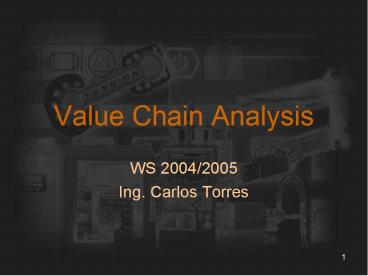Value Chain Analysis - PowerPoint PPT Presentation
1 / 8
Title:
Value Chain Analysis
Description:
Auto. PC. Large farms. Vertical integration farmer and ... Trader. Local cooperatives. OBM, Retailers. OBM, OEM. OBM, OEM. Auto producers. Auto producers ... – PowerPoint PPT presentation
Number of Views:1031
Avg rating:3.0/5.0
Title: Value Chain Analysis
1
Value Chain Analysis
- WS 2004/2005
- Ing. Carlos Torres
2
Termine
- 12. Januar Mapping Value Chains. Das Beispiel
der Lachs-Industrie in Chile - 19. Januar Verwendung von Konzepten zur
Fallstudien - 26. Januar Gruppen Präsentationen
- 02. Februar Wertschöpfungskette-Analyse als
analytisches Instrument
3
(No Transcript)
4
(No Transcript)
5
Wertschöpfungskette-Analyse als analytisches
Instrument
Quelle Meier, G. 1998
6
Wertschöpfungskette-Analyse als analytisches
Instrument Policy
Traditional View Comparative Advantage and
Productivity
Quelle Meier, G. 1998
7
Wertschöpfungskette-Analyse als analytisches
Instrument Policy
- Value Chain View
- Core activities (functional)
- Dynamics and distribution of rent
(intersectoral) - Division of production (geographically)
- Examples Industrial Policy
- Computer promotion of functional upgrading
(learning capacity) development of suppliers
(supporting industries) - Automobile First tier supplier (promotion of
competition) - FFV product development, logistic, small farmers
development, traceability - Apparel 1. OEM model promotion of functional
upgrading - 2. Assembly model backward linkages
(textile) - Coffee stabilisation funds, market niches,
association
8
Wertschöpfungskette-Analyse als analytisches
Instrument Firm-Strategie
- Traditional View Advantage of firms , Market
changes - Value Chain View dynamic strategy
- Governance structures
- Down and upstream influences
- Upgrading possibilities
- Rent-rich activities, value added concept
(functional upgrading) - Management capacity to anticipate changes
- Factor supplies, quality and prices,
technological gaps, dynamics of innovations
(upgrading), variable learning curves - Governance structures and increasing return to
scale (marketing) move in - New barriers to entry (traceability) learning
process































